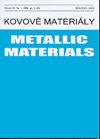水平连续单向凝固Cu-Sn合金表面渗出物的形成机理
IF 0.7
4区 材料科学
Q4 MATERIALS SCIENCE, MULTIDISCIPLINARY
引用次数: 0
摘要
Cu-5wt。采用水平连续单向凝固(HCUS)技术制备了%Sn合金。HCUS Cu-5wt的显微组织。采用光学显微镜和扫描电镜对%Sn合金进行了分析。同时,利用数值模拟软件ProCAST对HCUS Cu 5wt的Sn分布进行了模拟。%锡合金。结果表明:HCUS Cu-5wt下表面存在严重的渗出层;%Sn合金,而合金上表面几乎没有渗出层。仿真结果表明,在HCUS过程中,中心的固液界面向液体突出。在模具和合金之间形成一个狭窄的间隙。在凝固过程中,锡溶质由固体析出为液体。因此,枝晶之间的液体熔点低,在模具温度高时不凝固。这些液体在重力作用下向下流入空隙中,并在最后阶段凝固,在下部表面形成富含锡溶质的渗出层。本文章由计算机程序翻译,如有差异,请以英文原文为准。
Formation mechanism of surface exudation in Cu-Sn alloy prepared by horizontal continuous unidirectional solidification
The Cu-5wt.%Sn alloy was prepared by using the horizontal continuous unidirectional so-lidification (HCUS) technique. The microstructure of HCUS Cu-5wt.%Sn alloy was analyzed by optical microscope and scanning electron microscope. Meanwhile, numerical simulation software ProCAST was used to simulate the Sn distribution of HCUS Cu 5wt.%Sn alloy. The results show that there exists a serious exudation layer on the lower surface of the HCUS Cu-5wt.%Sn alloy, while there is almost no exudation layer on the upper surface of the alloy. The simulation results show that the solid-liquid interface in the center protrudes to the liquid during the HCUS process. A narrow gap is formed between the mold and the alloy. During solidification, Sn solute is precipitated from solid to liquid. Therefore, the liquid between dendrites has a low melting point and does not solidify at high mold temperatures. These liquids flow down into the gap due to gravity and solidify at the last stage, forming an exudation layer on the lower surface enriched by Sn solute.
求助全文
通过发布文献求助,成功后即可免费获取论文全文。
去求助
来源期刊

Kovove Materialy-Metallic Materials
MATERIALS SCIENCE, MULTIDISCIPLINARY-METALLURGY & METALLURGICAL ENGINEERING
CiteScore
1.20
自引率
14.30%
发文量
36
审稿时长
3 months
期刊介绍:
Kovove Materialy - Metallic Materials is dedicated to publishing original theoretical and experimental papers concerned with structural, nanostructured, and functional metallic and selected non-metallic materials. Emphasis is placed on those aspects of the science of materials that address:
the relationship between the microstructure of materials and their properties, including mechanical, electrical, magnetic and chemical properties;
the relationship between the microstructure of materials and the thermodynamics, kinetics and mechanisms of processes;
the synthesis and processing of materials, with emphasis on microstructural mechanisms and control;
advances in the characterization of the microstructure and properties of materials with experiments and models which help in understanding the properties of materials.
 求助内容:
求助内容: 应助结果提醒方式:
应助结果提醒方式:


